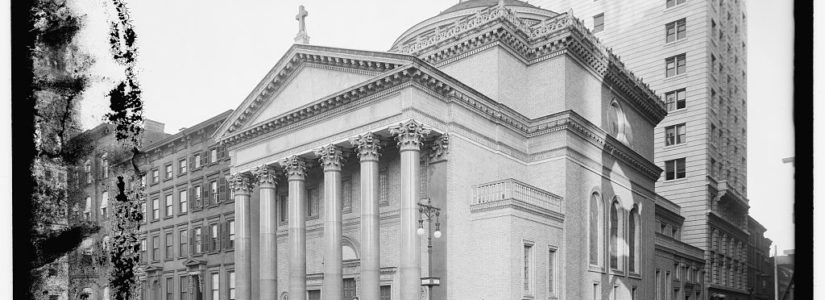
When Salvage Tells a Story: Friends of Terra Cotta Follows Archival Trail to Locate Missing Pieces of Demolished Church
May 14, 2012 | by Elizabeth Rohn Jeffe, Vice-Chair
Article from the Spring 2012 Newsletter
Proof positive that salvage can reveal the story of what was lost and what was saved after the destruction of an important edifice lies in the detective work of Susan Tunick, president of Friends of Terra Cotta, who created an archival trail to trace the fate of the vestiges of Madison Square Presbyterian Church (MSPC). Designed by Stanford White to replace an earlier Gothic church on 24th Street at the corner of Madison Avenue, the lovely house of worship was dedicated in 1906. Just 13 years later, however, MSPC was demolished, its lot destined for an annex to the Metropolitan Life Insurance Company Tower, a neighbor on Madison Avenue. But all was not lost. Although a brief preservation battle supported by the American Scenic and Historic Preservation Society, founded by early preservationist Andrew Haswell Green, failed to save the church, various interested parties did recover a wide variety of salvage items.
MSPC, a strikingly beautiful Palladian structure, was especially significant in its era for its extensive use of colored, glazed terra cotta on its façade. Few buildings were using this decorative element on their exteriors, and MSPC was the most imposing edifice to do so. Given these facts, terra cotta scholar Tunick wanted to locate actual examples of the terra cotta units so that their appearance could be accurately assessed. As Tunick observed in a recent interview, “It’s one thing to read a description of glaze color, and another to view it. Period publications considered the colors to be discreet, not garish. But we wanted to see for ourselves what that actually meant.”
Knowing that some elements from the Madison Square Presbyterian Church had been salvaged at the time of demolition, Tunick made it her business for 30 years to track down their whereabouts. She was aided in the past decade by two colleagues: art historian Nina Gray, and journalist and Friends of Terra Cotta member Eve M. Kahn. (The latter wrote an article on the subject in the December 2, 2011 New York Times entitled, “Madison Square Church Survives in Fragments.”) Tunick’s assiduous research encompassed a variety of archival sources ranging from the 25th Annual Report of the American Scenic and Historic Preservation Society (1920) and various period New York Times articles, to the March 1921 Ohio State Engineer and a letter in the archives of the Metropolitan Museum of Art.
As a result of her long quest, Tunick was able to discover various salvage elements of the lost church in far-flung and at times quite surprising locations. Six granite column shafts were saved by architect Donn Barber who incorporated them, along with other salvage materials including terra cotta from the upper and lower cornices, into his Hartford Times building in Hartford, Connecticut. This structure is still standing, providing a view of the church’s terra cotta elements. Another architect, “Dutch” Gugler, saved a Corinthian capital that eventually found a home outside Brown Hall of the School of Architecture at Ohio State University. The stained glass windows from the church, designed by MSPC congregant Louis Comfort Tiffany, now adorn the Saint Francis of Assisi Chapel at the Mission Inn Hotel & Spa in Riverside, California.
Still other salvage pieces have been found closer to home. The Brooklyn Museum of Art owns the main entryway of the church that was once installed in the museum and later dismantled. Its whereabouts were then unknown until the museum reorganized its storage; now the museum is considering exhibiting the entryway again at a future date. According to Eve M. Kahn, in the New York Times article cited above, a hearth at Box Hill, Stanford White’s St. James, Long Island home, contains some pieces of the church’s decorative elements. This information surfaced through an email from architect Samuel White, a grandson of Stanford White. Last, but not least, numerous salvage items found homes in the First Presbyterian Church on West 12th Street following the merger of the two congregations when MSPC was demolished. These articles include a large exterior cross, a lectern, a hammered iron lighting fixture, a communion table, two wooden pews, and a Tiffany wall clock.
Unfortunately, not all of the salvage story relating to MSPC has a happy ending. The Metropolitan Museum of Art had at one time installed the 44-foot long pediment of the church, adorned with polychrome terra cotta, and two terra cotta medallions on the back wall of the museum’s library. When it was torn down during renovations in the 1960s and replaced with a new and larger library, the pediment and medallions were destroyed. Also, fragments of cornices and other elements that were donated to Columbia University’s School of Architecture are now missing.
In addition to providing important information to many audiences—art and architectural historians and preservationists among them—Tunick and her research team have also bolstered the mission of the Archive Project by demonstrating how important archival trails are to the telling of the preservation story. In this instance, critical information about still extant elements from Madison Square Presbyterian Church has been unearthed, making it possible for anyone interested in visiting the various sites to experience what remains of the church’s beauty firsthand. Susan Tunick and the Friends of Terra Cotta serve as role models by demonstrating how to track the resting places of the parts of a once magnificent building, and saving for posterity one chapter in the ongoing New York City preservation saga.




